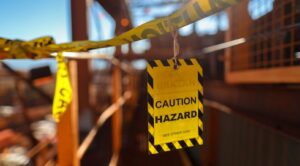Elimination of Hazards Meeting Kit

ELIMINATION OF HAZARDS SAFETY TALK
When discussing how to mitigate hazards in the workplace there is a hierarchy of controls that is often referred to.
A common version of the hierarchy from most effective to least effective control is listed as: elimination, substitution, engineering controls, administrative controls, and PPE. Elimination should always be considered first when attempting to mitigate hazards in the workplace.
WORKPLACE HAZARDS
- Exposure to Chemicals
- The Risk of Fire
- Repetitive Use Injury
- Injury due to Electrical Hazards
ACCIDENTAL FALLS AND FALLING OBJECTS
If your employees work at elevated heights, they may be at risk of accidental falls. Anytime objects are stored at or above head level, there is a risk of injury caused by falling objects.
HUMAN RESOURCES HAZARDS
Not all hazards are purely physical. Psychosocial hazards that cause stress and emotional distress can result in injury, illness, poor health and behaviour, as well as disengagement, absenteeism, and resignation.
HIERARCHY OF CONTROLS REDUCE OR ELIMINATE HAZARDS
- Elimination
Elimination of hazards is the most effective way to protect employees against injuries. However, far too often companies or individual employees do not take the time to plan out work tasks or the time to actually eliminate the hazards they are faced with. Everyday millions of workers are faced with hazards that they do not need to be exposed to.
Proper planning of work, thinking about alternative safer ways to complete a work task, and allocating the necessary resources to complete the task are some of the first steps supervisors can take to begin to eliminate hazards. At the worker level, hazard recognition and the elimination mindset is important to ensure any additional hazards are eliminated.
- Substitution
Substitution means replacing the process or item that causes a hazard with one that does not. For example, replacing a solvent-based degreaser with a citrus-based degreaser is a substitution that reduces air emissions and is typically less harmful to employees and the environment. When considering substitution methods and products, it is important to review them thoroughly to ensure that they do not create new hazards.
- Engineering Controls
Several workplace safety regulations, such as the ones listed below, require engineering controls as a line of defense against hazards. Often, these controls can be worked into the design of the equipment or process. They can also take the form of barriers, guards or enclosures.
- Hazard Communication
- Lockout/Tagout
- Respiratory Protection
- Confined Space Entry
- Blood borne Pathogens
- Hearing Conservation
- Laboratory Chemical Hygiene
Engineering controls are usually permanently installed devices that remove the need for an employee to remember to do or wear something to work safely. That is why they are considered the best option for managing unavoidable safety hazards or risks.
- Administrative Controls
Forms of administrative controls include standard operating procedures, established safe work routines, employee training and emergency response drills. They can also include what some might consider “creature comforts,” such as taking frequent breaks when working in extreme heat or cold and rotation of job functions. These activities do serve a safety function. Scheduling downtime to perform preventive maintenance and routine inspections can also be directly tied to safety controls, because they minimize the chance for malfunctions that could put employees at risk for injury or death.
- PPE
When engineering and administrative controls aren’t enough to keep employees safe, the balance of the safety load falls on PPE. Although PPE is a form of protection, it is the last line of defence against hazard.
- It has to fit correctly to be effective. A good example of this is respiratory protection. If you can’t get a good seal, it’s not going to work well.
- It has to be worn. Yes, you can get a pair of safety glasses for a couple bucks. But if they’re not comfortable, or if they fog up in hot weather s no one wants to wear them, you’re probably wasting your money. They either won’t be worn, or only if someone vigilantly polices each work area to make sure of it.
- It has to be removed from service when it has passed its prime. Nothing lasts forever, especially PPE. A frayed fall harness, safety shoes with smooth soles, glasses with severely scratched lenses and gloves with holes.
- Employees need to know about hazards in their workplace and how engineering and administrative controls, in combination with PPE, help them work safely. They also need to be taught how to wear, use and take care of any PPE that they’ve been issued so that it is truly effective and provides that last line of defense against a safety risk.
FINAL WORD
Eliminating hazards and substituting less hazardous products are not always possible. Retrofitting machines with engineering controls can be expensive. Administrative controls take time from production schedules. Getting everyone to wear their PPE can be a pain. But bringing together all of these elements is the only hope for eliminating the chance of an employee’s duties causing injury, illness or death.